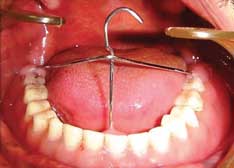Impact of single implant versus two-implant mandibular retained overdentures on retention and success rate in totally edentulous patients. A Randomized Controlled Clinical Trial

All claims expressed in this article are solely those of the authors and do not necessarily represent those of their affiliated organizations, or those of the publisher, the editors and the reviewers. Any product that may be evaluated in this article or claim that may be made by its manufacturer is not guaranteed or endorsed by the publisher.
Authors
Aim Purpose of this RCT was to evaluate the denture retention and success rate of totally edentulous patients in single median versus two inter-foraminal implant-supported mandibular over-dentures on.
Material and methods Twenty-four totally edentulous patients were selected in this trial. The eligible patients were allocated randomly into two equivalent groups of 12 participants each. A single-implant (G I) or two inter-foraminal implants (GII) were located in the mandible. Three months later, pick up of the locator attachment wa performed to all implants and denture bases. Assessments of denture retention and success rate of implants were measured at the three, six, and twelve month's follow-up assessments. The study consists of twenty-four totally edentulous patients (14 males and 9 females) with age range of 59.6 years. Thirty six implants were inserted (12 in single-implant and 24 in the two inter-foraminal implants). All patients accomplished the twelve months period of follow-up.
Results Regarding denture retention, the two inter-foraminal implant group (GII) showed statistically significant differences compared to the single-implant group (GI). Concerning success criteria of implants the results revealed insignificant differences between patients in both groups.
Conclusion Single-implant mandibular over-dentures may be recommended as an alternate treatment option for the management of edentulous patients in populations with low economic status.
2. Attard N, Zarb G. Long-term treatment out-comes in edentulous patients treated with fixed implant-supported prostheses. Int J Prosthodont 2004;17:417-424.
3. Emami E, Heydecke G, Rompré PH, De Grandmont P, Feine JS. Impact of implant support for mandibular dentures on satisfaction, oral and general health-related quality of life: A meta-analysis of randomized- controlled trials. Clin Oral Implants Res. 2009;20:533-544.
4. Feine JS, Carlsson GE , Awad MA, Chehade A, Duncan WJ GS et al. . The McGill consensus statement on overdentures. Mandibular two-implant-overdentures as first choice standard of care for edentulous patients. Montreal, Quebec. Int J Oral Maxillofac Implant. 2002;17:601-602.
5. Thomason JM, Feine J, Exley C, Moynihan P, Mu¨ller F, Naert I, Ellis JS, Barclay C, Butter- worth C, Scott B. Mandibular two implant-supported overdentures as the first choice standard of care for edentulous patients-the York Consensus Statement. Br Dent J 2009;207:185-186.
6. Cordioli G, Majzoub Z, Castagna S. Mandibular overdentures anchored to single implants: A five-year prospective study. J Prosthet Dent. 1997;78:159-165.
7. Kronstrom M, Davis B, Loney R, Gerrow J, Hollender L. A Prospective Randomized Study on the Immediate Loading of Mandibular Overdentures Supported by One or Two Implants; A 3 Year Follow-Up Report. Clin Implant Dent Relat Res. 2014;16(3):323-329.
8. Bryant SR, Walton JN, MacEntee MI. . A 5-year randomized trial to compare 1 or 2 implants for implant overdentures. J Dent Res 2015;94:36-43.
9. Kronstrom M, Davis B, Loney R, Gerrow J and Hollender L. Satisfaction and Clinical Outcomes Among Patients with Immediately Loaded Mandibular Overdentures Supported by One or Two Dental Implants: Results of a 5-Year Prospective Randomized Clinical Trial Int J Oral Maxillofac Implants. 2017; 32(1):128-136.
10. Tavakolizadeh S, Vafaee F, Khoshhal M, Ebrahimzadeh Z. Comparison of marginal bone loss and patient satisfaction in single and double-implant assisted mandibular overdenture by immediate loading. J Adv Prosthodont 2015;7:191-198.
11. Geertman ME, van Waas MA, van€™t Hof MA and Kalk W. Denture satisfaction in a comparative study of implant-retained mandibular overdentures: A randomized clinical trial. Int J Oral Maxillofac Implants. 1996 b; 11(2):194-200.
12. Zitzmann NU and Marinello CP. A review of clinical and technical considerations for fixed and removable implant prostheses in the edentulous mandible. Int J Prosthodont. 2002;15:65-72.
13. Sadig W. A comparative in vitro study on the retention and stability of implant- supported overdentures. Quintessence Int. 2009; 40: 313-319.
14. Abi Nader S, De Souza RF, Fortin D, De Koninck L, Fromentin O, Albuquerque Junior RF. Effect of simulated masticatory loading on the retention of stud attachments for implant overdentures. J Oral Rehabil. 2011;38(3):157-164.
15. Esposito M, Hirsch JM, Lekholm U and Thomsen P. Biological factors contributingto failures of osseointegratedoral implants. (I) Success criteria and epidemiology. Eur J Oral Sci. 1998; 106: 527-551.
16. Alsabeeha N, Payne AG, De Silva RK, Swain MV. Mandibular single implant overdentures: a review with surgical and prosthodontic per- spectives of a novel approach. Clin Oral Implants Res 2009;20:356-365.
17. Kleis, WK, Hartmann S, Al-Nawas B and Wagner W. A comparison of three different attachment systems for mandibular two-implant overdentures: one-year report. Clin. Implant Dent. Relat. Res. 2010; 12 (3):209-218.
18. Williams BH, Ochiai KT, Baba T and Caputo AA. Retention and load transfer characteristics of implant-retained auricular prostheses. The International Journal of Oral and Maxillofacial Implants. 2007; 22: 366-372.
19. Jemt T, Book K, Lindén B and Urde G. Failures and complications in 92 consecutively inserted overdentures supported by BrÃ¥nemark implants in severely resorbed edentulous maxillae: A study from prosthetic treatment to first annual check-up. Int J Oral Maxillofac Implants 1992; 7:162-167.
20. Davis DM and Packer ME. Mandibular overdentures stabilized by Astra Tech implants with either ball attachments or magnets: 5- year results, Int J Prosthodont. 1999; 12(3):222-229.
21. Zitzmamn NU and Marinello CP. Treatment outcomes of fixed or removable implant - supported prostheses in the edentulous maxilla Part I: Patients€™ assessments. J Prosthet Dent. 2000; 83(4):424 - 433.
Edited by
Oral implantologyHow to Cite
The Journal of Osseointegration has chosen to apply the Creative Commons Attribution NonCommercial 4.0 International License (CC BY-NC 4.0) to all manuscripts to be published.


 https://doi.org/10.23805/jo.2018.10.03.03
https://doi.org/10.23805/jo.2018.10.03.03







